If you don’t want to make a day trip, 4000 bucks can survive in the crypto world. Listen to my practical advice! See how I use a month to do contract rolling compound interest: the core is just one sentence: rely on contract trading to amplify profits! If you plan to invest in crypto, please take a few minutes to read my answer word for word, as it may change your life and a family.
Thousands of originally happy families ultimately face ruin, stemming from the pursuit of an unreachable dream of making a fortune in the crypto world.
I believe the reason I can continue on the path of trading is that I have been quietly learning, in addition to understanding the basic knowledge,
Analyzing news, studying technical indicators, and forming a self-stabilizing profit trading system!
Let me present an executable plan. If you can execute it, making 100,000 from a few thousand is achievable.
Below, I will share my personally tested method: quickly go from a few thousand to 100k, the only method: (rolling positions)+
Step 1: First, split your several thousand into U into three parts!
Step 2: Do contracts three times + leverage 100, position each time 60%, full position, just do BTC or ETH, operation time: evening
Between 9:30 AM and 4 AM!
Step 3: Make three contracts, normally if you win all three, your capital will reach several thousand U, and if there is a big market, it can reach tens of thousands of U.
Step 4: Continue the previous day's operations, dividing the principal into three parts, the same operation three times!

My cryptocurrency trading strategy has only four steps, very simple, yet incredibly effective.
Step 1: Choose a cryptocurrency, open a daily level chart, only select cryptocurrencies with MACD golden crosses, prioritize golden crosses above the 0 axis, which is the highest success rate condition!
Step 2: Buy signal Switch to the daily chart and focus only on one moving average - the daily average line. The rules are simple:
Online holding: Buy and hold when the price is above the daily average line,
Sell offline: Sell immediately when the price drops below the daily average line.
Step 3: Position management After buying, observe the price and volume:
1. If the price breaks above the daily average line, and the volume also stabilizes above the daily average line, buy in full.
2. Selling strategy: · If the increase exceeds 40%: Sell 1/3 of the position. · If the increase exceeds 80%: Sell another 1/3 of the position. If it drops below the daily average line: Clear out all remaining positions.
Step 4: Strict stop loss. The daily average line is our operational core. If the price suddenly drops below the daily average line the next day, regardless of the reason, you must sell all positions; don't harbor any luck!
Although the probability of dropping below the daily average line is low through this screening method, we still need to maintain risk awareness. After selling, just wait for the price to stabilize above the daily average line to buy back.
This method is simple and easy to learn, very suitable for investors who want to profit steadily. Remember, the key to success is strict execution of every step without being swayed by emotions!
The crypto market is ruthless; I was once that high-priced bag holder, the 'chives' who got liquidated, 100,000 U vanished into thin air, leaving only 5,000 U struggling
But three months later, this 5000 U turned into 280,000 U. This is not motivational talk, but a set of extreme market strategies against human nature.
Today, I will publicly share part of the core logic, suitable for 'desperate players'.
Step 1: The 'Positioning Rule' of 5000 U
After a loss, the most taboo is 'revenge trading'. You must admit: 5000 U is not for recovering losses, but for 'making bullets'.
Strategic choices:
If you are skilled in short-term trading, focus on BTC/ETH's 5-minute level fluctuations, only do reverse strikes after 'panic spikes' (must be combined with on-chain data)
If there is no time to monitor the market, bet on the 'death rebound' at the end of the 'shanzhai season' (like DOGE in 2021, PEPE in 2023)
But it must meet: Market cap top 100 + 24-hour trading volume > 50 million U + sudden social media activity
Step 2: The 'three times leverage trap' of violent compound interest
Don't be tempted by hundred-fold contracts; my key to turning around is actually 3x leverage + timed withdrawals:
Open only 3 times at 3x leverage, withdraw the principal immediately when 50% profit, and continue rolling with the profit part.
Example: 5000 U opening 3x long BTC, increase 10% → capital becomes 6500 U, withdraw 5000 U, remaining 1500 U profit full position again at 3x
Risk locked, profits unlimited.
You can observe: when a cryptocurrency appears simultaneously:
The exchange's stock has suddenly dropped by 30%+
Contract funding rate extremely negative
—— This is the precursor to a 'violent rebound'. There are no guaranteed profits in crypto, but there are definitely high probabilities.
The market is always changing, but the rules remain unchanged. Your only goal is: In this great wave of sand washing, do not get washed away. If you feel lost, you might as well bookmark this article as the starting point of your trading journey. Not to get rich quickly, but to stay at the table!
Want to profit in the market
Especially in the crypto world
You may not recognize some very profound economic theories
You may not understand the indicators behind every economic data
You can more easily ignore all technical indicators
Completely unnecessary
But there is one thing you must understand thoroughly
This matter is the bullish and bearish candles (K-line)
If you are just starting to engage in trading
You might find bullish and bearish candles very complex
Completely unable to understand what is going on
But don’t worry
This matter is not as complicated as imagined
I will use a very simple and clear method in this article
Lead you step by step to understand this matter
Friends who like this article remember to give me a like at the bottom
Your support is my motivation!
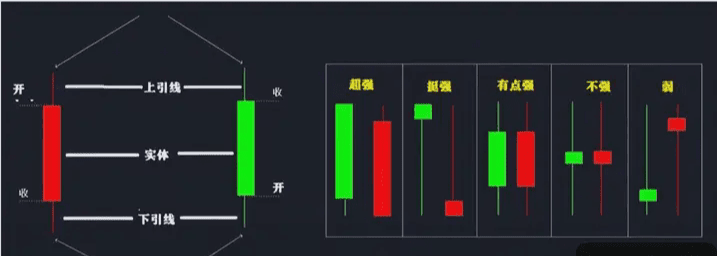
Within a chart
Nothing is more important than price
And the bullish and bearish candle uses an image method
It shows the fluctuation of price within a specific time
The result of the bull and bear sides clashing
How the market thinks about direction
Which side has control, etc.
All of the above can find some clues through bullish and bearish candles
Bullish and bearish candles are the threshold to enter technical analysis
If we understand the meanings behind each bullish and bearish candle
Regardless of which type of technical analysis you personally prefer
Can achieve twice the result with half the effort
Next
I will lead everyone to interpret bullish and bearish candles in three levels (three layers)
First, I will break down the bullish and bearish candles into four parts
To interpret its superficial information
Then I will summarize the bullish and bearish candles into five different strengths
To interpret the hints that bullish and bearish candles give us
Finally, I will introduce four of the most common bullish and bearish candle formations
How to define them,
Their meanings and application methods
After watching, you will understand
How to find a lot of helpful information for your market analysis through bullish and bearish candles
At the same time, you will understand
Why I say that bullish and bearish candles are the foundation of market profit
Let's start right away!
Novice on the road
1
Novice on the road
We start from the first grade:【Novice on the road】
Here I will teach everyone how to interpret the superficial information that a bullish and bearish candle brings us
When breaking down a bullish and bearish candle
Can be divided into four key points
These include color, opening and closing high and low, body, and shadows
Before talking about the four key points, we first need to know one thing
Each bullish and bearish candle represents the price fluctuation within a certain time period
If you are using a one-minute chart
Each bullish and bearish candle records the price fluctuation within that minute
If you are using a daily chart
Then each bullish and bearish candle records the fluctuation of price in the past 24 hours
Color is our method of distinguishing whether this bullish and bearish candle is a bullish candle or a bearish candle
Generally, red represents a bearish candle
And green represents a bullish candle
A bullish candle means that the closing price is higher than the opening price within a specific time period
And the bearish candle is the opposite
When the bearish candle ends
The closing price is lower than the opening price
So we can know through the color of the bullish and bearish candles that
It indicates whether the temporary control in the market is in the hands of buyers or sellers
Then it's about opening, closing, high, and low
I believe you have mastered these basic concepts
This matter is very simple
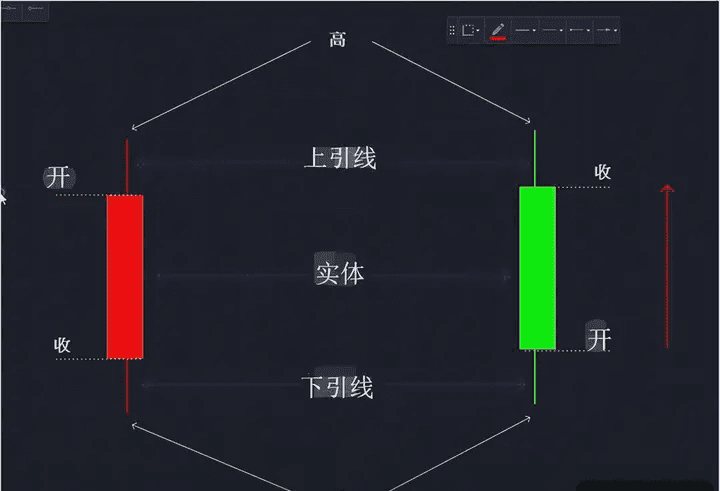
We each take bearish and bullish candles as examples
The bullish candle is from top to bottom: opening high, closing high, opening low
Just like what was said earlier
Its closing price is above the opening price
The bearish candle is from top to bottom: opening high, closing low
Opposite to the bullish candle
Its closing price is lower than the opening price
Next, let's talk about the body line
The body means the real price movement range within a specific time
Using a daily chart's bullish and bearish candle as an example
For example, its opening price this morning was 10 dollars
After a day of repetitive trading
Regardless of whether it has ever risen by 15 dollars
Or whether it has ever dropped to 7 dollars
This position will only record the price at the moment the bullish and bearish candles end
Its price is what it is
Finally, there are the shadows
The shadows represent the high and low prices that were once reached
Many important messages can be seen from the shadow
I personally think that shadows are a very important part of interpreting the market
Here temporarily sell a suspense
In the last part, I will use the bullish and bearish candle formations (K-line formations)
Explain it more clearly in detail
The secrets behind the bullish and bearish nature
2
Secret
OK
Congratulations on completing the first level【Novice on the road】 course
Next
We start to delve deeper
If we use watching a movie as a metaphor
When you finish appreciating a play
You know the development of the plot of the story,
The information that the movie superficially brings you
Would you want to think a bit further about this movie?
It wants to convey deeper meanings and information
Would you have some insights and personal interpretations?
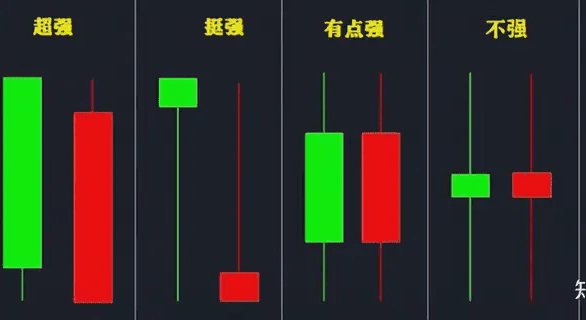
If this concept is applied to the market
Each K-line represents a story
This story has both long and short
Short ones can be less than a minute
And long ones can exceed a month
Depends on what time frame you are using
Every story also has a beginning, process, and ending
Superficially, this daily chart's bullish and bearish candle tells you:
My opening price was 10 dollars, and within 24 hours it reached a high of 18 dollars. The previous low was 7 dollars, and my closing price was 13 dollars
These are the plots of a story
If we delve deeper into interpreting and reflecting on this story
You will have many surprising discoveries
And these discoveries can effectively help you interpret the market
Next, we will enter the second grade【The secrets behind bullish and bearish candles】
I will use several examples based on intensity
Explain in more detail to you
The secrets brought to us by different types of bullish and bearish candles
Here I will categorize the bullish and bearish candles into five different strengths
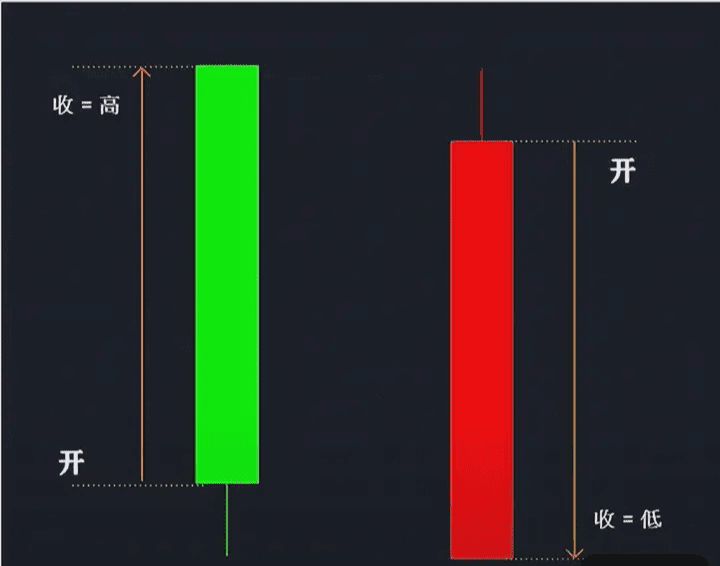
The first type
Long body
And there are hardly any shadows
For the strongest bullish and bearish formation
The body represents that one side almost completely has control
Taking this bullish candle as an example
The buyer has intention
And has the ability to push prices up within a specific time
On the other hand
The shadow part is almost invisible
Represents no or very weak opposing force
We see that the upward or downward forces are almost unobstructed
It represents that most participants in the market agree that the price moves in this direction
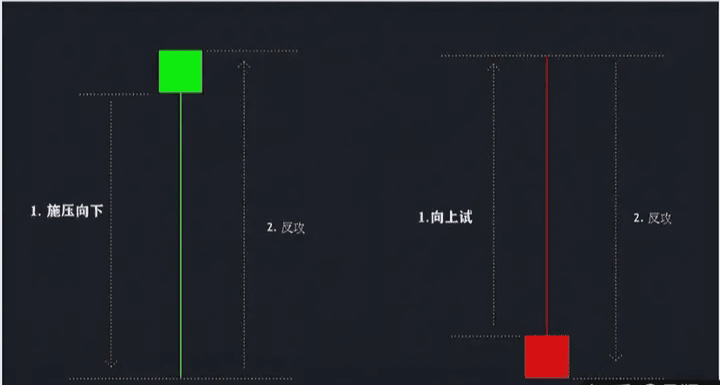
The second type
We see that this type of bullish and bearish candle has a long shadow
It was once a bullish or bearish candle with a very large body
But once faced very strong opposing pressure
The defensive side shows strong determination and strength
In the end, all lost ground is successfully recovered
Still having control when the bullish and bearish candles end
Although its body is relatively short
But if we think deeper about it
Then you will understand
It does not walk a shorter distance than the first type of bullish and bearish candles
This type of bullish and bearish candle is called a shooting star or hammer candle
We will look at some chart examples together later

OK
To the third type of bullish and bearish candles
The body of this type of bullish and bearish candle is actually not considered short
However, there is a place that will greatly diminish our impression of it
This place is the shadow
Let's take the bullish candle as an example
The price once surged to a high point
But encounters opposing forces increasing
We see
This bullish candle has a shadow at the top
The shadow represents rejection
That is, the sellers recover some lost ground
Compared to the previous two types that are resolute
We see hesitation and reservation here
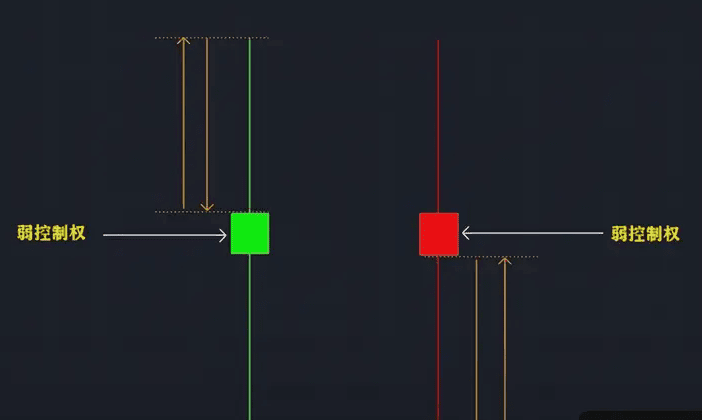
The fourth type
These types of bullish and bearish candles
Not only is it short in body
And each has a long tail above and below
Indicates that both sides have launched attacks
But neither side is willing to back down
Both sides currently lack the strength to significantly break this deadlock
We can only use color to judge whether the buyer or seller still has a small part of the control
Everyone may feel that this type of K-line is very similar to the second type
But because they end at different places
So the entire meaning is completely different
Another main reason is that the shadows prove that the market temporarily has no clear direction
We call this bullish and bearish candle a doji
It could be a pause in a trend
Or the market is accumulating strength to reverse
Generally speaking, when the market is in a directionless situation
We should not enter the market
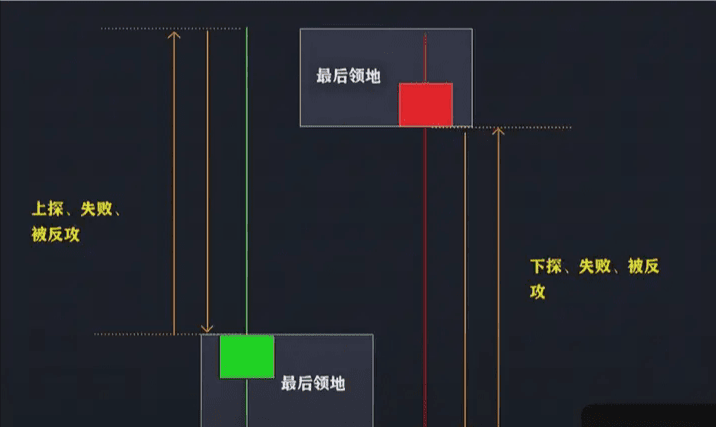
Fifth type
Then we get to the weakest bullish and bearish candles
We see that buyers or sellers have launched attacks upwards or downwards respectively
Encountering strong resistance and rejection
Ultimately ending in failure
Once seemed to have the whole world
But unfortunately, it was counterattacked by the opponent
And also retreating step by step
At the end of the bullish and bearish candles
Can only cling to your last remaining territory
The situation is quite dangerous
If you are trading in the direction of the trend at this moment
Then you really have to be careful
OK
Having seen this
I believe you already have a considerable understanding of the bullish and bearish candles
We have finally arrived at the most important part
That is the third level【K-line formation】
We have separately discussed the four components that make up a bullish and bearish candle
And the meanings behind the five different types of intensity bullish and bearish candles
Next, we will base on the knowledge we just learned
Learn some quantifiable techniques
Bullish and bearish candle formations that can be truly used for trading
I will teach everyone the four most common bullish and bearish candle formations (K-line formations)
I will use chart examples to explain their definitions
The principles and application methods of formation
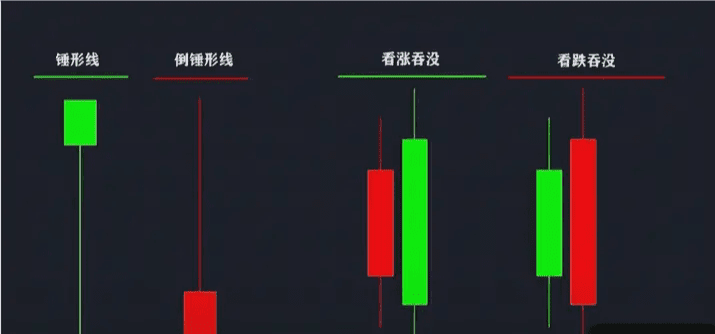
They are respectively
Hammer candle
Bullish engulfing
Shooting star
Bearish engulfing
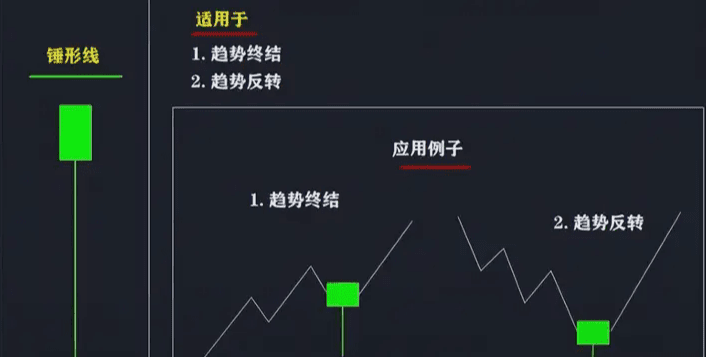
Hammer candle
We will start with the hammer candle
The hammer candle is composed of a single bullish and bearish candle
There are three conditions
They are either very small or have hardly any upper shadow
The lower shadow must be at least 2 to 3 times the body
The price should end above 25% of the entire bearish and bullish candle
The meaning of this formation is:
When the bullish and bearish candles begin
The sellers have launched an attack downwards over a distance
Then the buyers counterattack
Even the buyers' strength is even stronger
Until the bullish and bearish candles completely end
The buyers successfully reclaimed most of the lost ground
Also snatched control
This formation is a very favorable proof
The buyers begin to participate in the market
This is a favorable bullish and bearish candle formation
Generally used in situations where trends continue and reverse
Here is a fallacy:
This is what many online teachings say is just a trend reversal formation
Actually, their descriptions are still somewhat inaccurate
Let's take a look at the following two examples
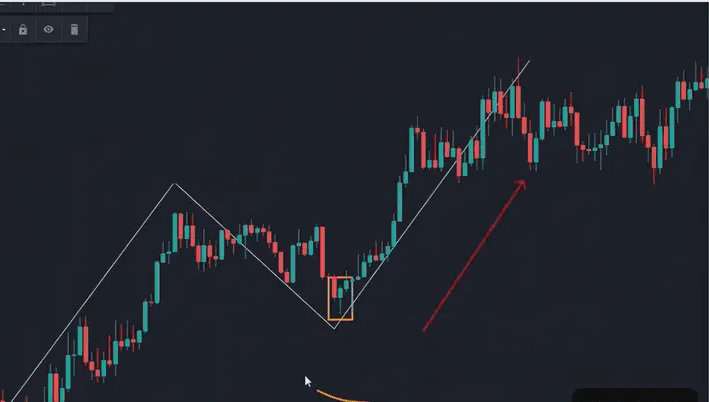
The first example of the trend continuing
When we see an upward trend
Immediately followed by an inverted hammer formation during the pullback
If we use price to define a trend applied to this example
This is a higher point
This is a relatively low point
We see an inverted hammer at a relatively low point
Then we can expect the trend to continue
Create a new higher point
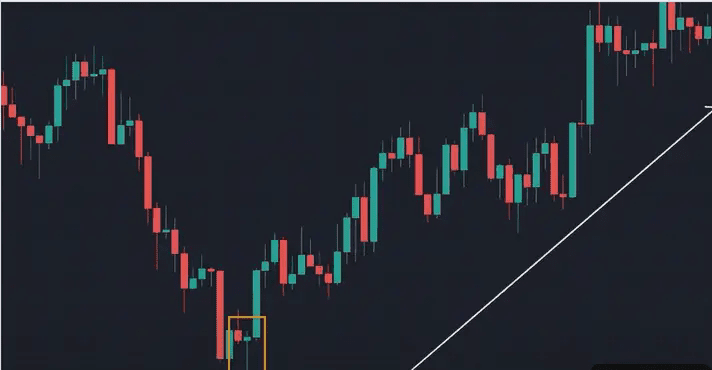
The second example of a trend reversal
When a downward trend reaches a certain extent
A shooting star formation appears
Indicating that the buyers’ strength is starting to appear, gaining control
The price starts a new trend
Bullish engulfing
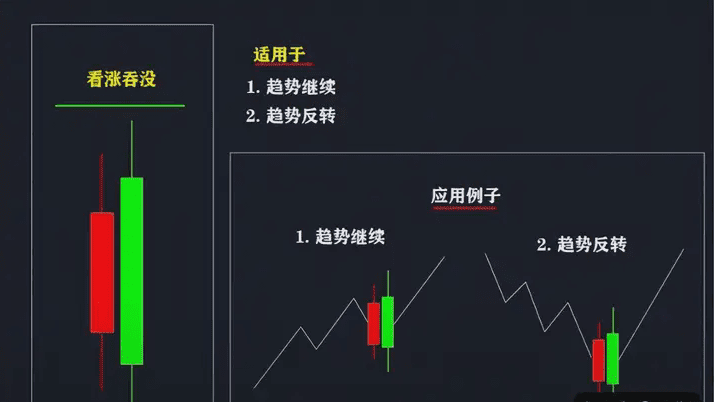
The second example is a bullish engulfing
Bullish engulfing is a bullish candle formation consisting of two K-lines
We define with three conditions
Is a bullish engulfing effective or not
They are
First: This formation must have a bearish candle immediately followed by a bullish candle
Second: The body of the bullish candle must completely cover the body of the previous bearish candle
The shadows here can be ignored
Third: The body of the bullish candle cannot be smaller than the body of the bearish candle
K-lines with too small bodies will be defined as dojis
And not a bullish engulfing
The meaning of this formation is that when the price drops to a certain position
A stronger opposing force appears
In addition to gaining control
Closing price is higher than the opening price of the previous candle
Proving that the market's sentiment has changed
This is a favorable bullish and bearish candle formation
Also applicable to situations where trends continue and reverse
Let's look at the following two application examples
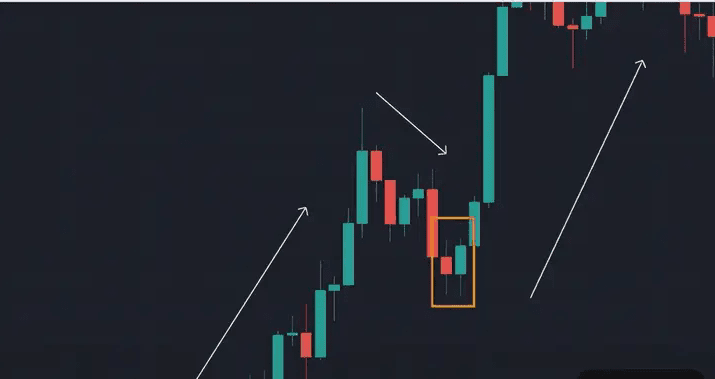
The first example
In the case of the trend continuing
When we see an upward trend
Immediately followed by a bullish engulfing formation at the pullback position
This is a very good signal
Proving that the brief reverse pullback has ended
Buyers officially return to reclaim the home court
The price continues to rise
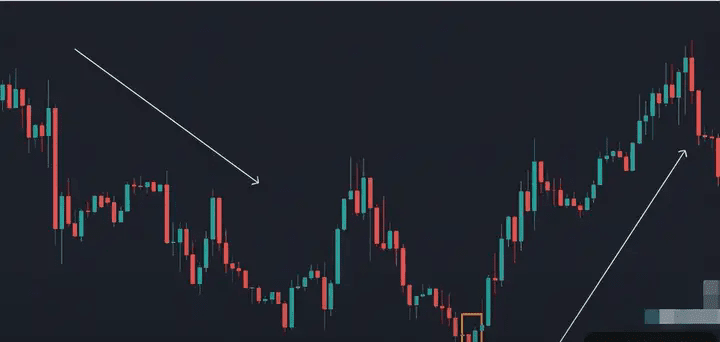
The second example of a trend reversal
In a downward trend to a certain extent
A bullish breakout formation appears
Buyers find opportunities to enter the market
Even the strength is stronger than the sellers
To reverse the price

Shooting star
Next, we learn two bearish K-line formations
The shooting star is actually similar to the hammer candle we just discussed
It's just that the direction has changed
The shooting star is a bearish formation formed by a single bullish and bearish candle
An effective shooting star
Also has three conditions
They are either very small or have hardly any upper shadow
The upper shadow is at least 2 to 3 times the body
The price must end below 25% of the entire K-line
The name of the shooting star formation
It actually reflects its meaning
Shooting arrows into the sky
Once reached a very high point
Exhausted and stopped
Slowly retreat downwards
Forming a very long shadow
This formation is also applicable to situations where trends continue and reverse
Everyone can refer to the earlier example of the hammer candle
All formations can be applied to the shooting star
I won't repeat the examples here
But
I want to talk about another popular usage
It is a combination of shooting star and moving averages
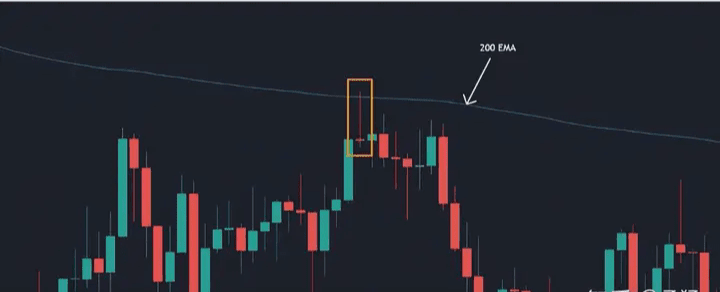
I will use a 200 EMA as an example
Moving averages are actually the market's balance point
The most fatal mistake most of us make using moving averages
It's like making trading signals such as golden crosses and dead crosses
Because it completely ignores the price and the balance point
That is, the interaction between moving averages
The correct use of EMA should be like this
When the price approaches the EMA
Once tried to surge upwards
We know that moving averages are actually a form of dynamic support and resistance levels
In other words
That is to say, the price tells you through a shooting star:
I once wanted to break this moving average and change the long-term trend, but failed, and I also had no more energy to continue upwards.
So the price returns to its original trend
Continue downward
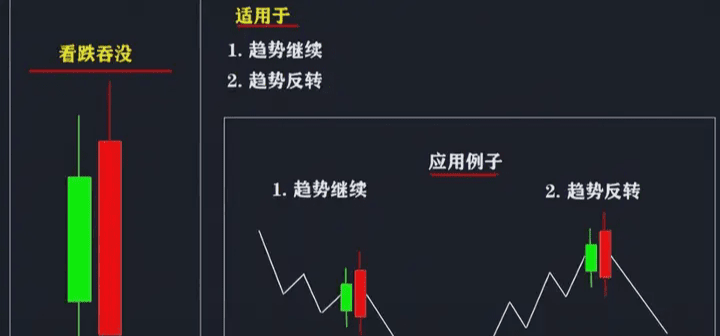
Bearish engulfing
The last example is the bearish engulfing
Bearish engulfing is a bearish candle formation consisting of two bullish and bearish candles
Similarly, I will use three conditions to define
First: This formation must have a bullish candle immediately followed by a bearish candle
Second: The body of this bearish candle must completely cover the body of the previous bullish candle
Third: The body cannot be too small
The meaning of this formation is also that the price rises to a certain position
Suddenly a stronger opposing force appears
Like a car slamming to a halt
Then immediately turn around
This formation is also applicable to examples of trend continuation and reversal
Just like the bullish engulfing we mentioned earlier
Reversing it would be
I won't repeat it here
I will combine major support and resistance levels with a bearish engulfing
Make a trading example
If you do not know what major support and resistance levels are
Don't know how to distinguish and find major support and resistance levels
Then click the link below the article
Go see the articles I wrote before

We see here
This is a major support and resistance level
I won't explain it in detail here
But at this position combined with bearish engulfing or similar K-line formations
Its win rate is very high
We see the price reach the main support and resistance levels
The next body immediately encounters opposing force
And this force is stronger than the sellers
Finally forming a bearish engulfing formation
Fully meets the conditions we define for this formation to be effective
After a bullish candle
Immediately followed by a bearish candle
The body of the bearish candle
Completely covers the body of the bullish candle
And the bodies also have sufficient length
Proving its determination to change trends
The price is naturally expected to go down
Conclusion
End
So regarding the K-line courses
We will stop here for today
Fans left messages a few days ago
Saying the length is too long
Suddenly unable to digest
So in the future, I will try to control the length of the article
Try to avoid making everyone feel that learning is a very stressful thing
But!
I have said
The trading market is the fastest way to realize technology
As long as you learn the techniques well
It can be realized immediately
No marketing needed
No need to rent a house
No need to stock up
No activities needed
No need to hire people
......
You don't even need to buy a computer
You can quietly make a fortune
Unlimited upward
But making money has never been that easy
If you just learned a little bit
They hurriedly enter the market
Then it can only mean losing both the wife and the soldiers
Opportunities have come, assets double! Follow Biao Ge closely to easily make big money
Keep an eye on: MAGIC, IDEX